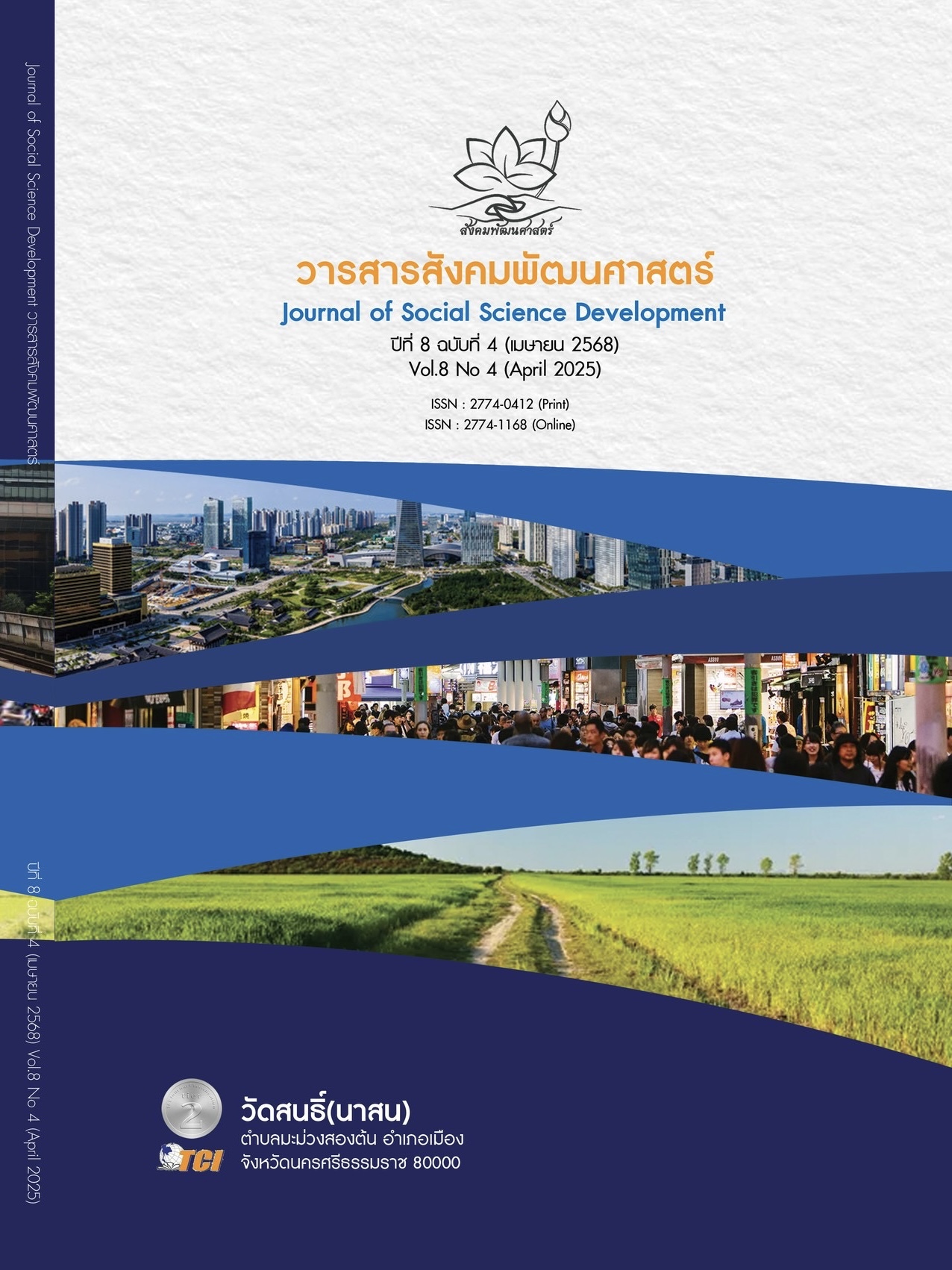MANAGEMENT OF THE PHANOM PHRA BOAT CULTURAL HERITAGE: APPROACHES FOR PRESERVATION AND SOCIAL VALUE ENHANCEMENT-A CASE STUDY OF WAT AMORNNUYUT, HUA SAI DISTRICT, NAKHON SI THAMMARAT PROVINCE
Main Article Content
Abstract
This research aimed to: study the management process of the cultural capital of Phanom Phra Boat Cultural Heritage of Wat Amaranuyut; analyze the factors influencing the success of the conservation and succession of the Phanom Phra Boat tradition; and evaluate the impact of the Phanom Phra Boat cultural capital management on the community in social, economic, and cultural dimensions. This was a qualitative research study. Key informants included 16 monks and temple committee members, 90 community members, and 3 cultural and handicraft experts, totaling 109 participants. They were selected using purposive and snowball sampling methods. The research instruments were in-depth interview and focus group discussion guides. Data were collected through interviews and focus group discussions and analyzed using descriptive analysis. The research findings on the management process of the cultural capital of Phanom Phra Boat of Wat Amaranuyut can be summarized as follows: 1) Planning and Resource Mobilization involved meetings and communication, the division of roles in the construction of the Phanom Phra Boat, and the development of operational plans. 2) The mobilization of local natural resources, support from government agencies, and the success resulting from collaborative efforts were evident. Factors contributing to the success in the conservation and succession of the Phanom Phra Boat tradition included: the success derived from community cooperation, the participation of youth in transmitting cultural heritage, the transfer of knowledge, support from government and private sectors, the establishment of networks and public relations, and sustainable conservation and development. The impact assessment of the Phanom Phra Boat cultural capital management in social, economic, and cultural dimensions revealed the strengthening of local identity, the creation of pride among local residents, the preservation of traditional knowledge, and the promotion of the community's culture to be known both locally and nationally.
Article Details

This work is licensed under a Creative Commons Attribution-NonCommercial-NoDerivatives 4.0 International License.
References
กรมส่งเสริมวัฒนธรรม. (2564). สมุดไทย: บันทึกภูมิปัญญาและวัฒนธรรมสยาม. (พิมพ์ครั้งที่ 2). กรุงเทพมหานคร: กรมส่งเสริมวัฒนธรรม.
__________. (2565). แนวทางการประสานงานเพื่อการอนุรักษ์วัฒนธรรมไทย. กรุงเทพมหานคร: กรมส่งเสริมวัฒนธรรม.
วิลาวัลย์ คำนิน และพงศ์สวัสดิ์ ราชจันทร์. (2567). แนวทางการอนุรักษ์กลองยาวอีสาน บ้านจุมจัง ตำบลอุ่มเม่า อำเภอโพนทอง จังหวัดร้อยเอ็ด. วารสารเมธีวิจัย, 1(6),19-33.
สำนักงานพัฒนาการวิจัยการเกษตร. (2565). การจัดการทุนทางวัฒนธรรมเพื่อยกระดับเศรษฐกิจชุมชนและสำนึกท้องถิ่น. กรุงเทพมหานคร: สำนักงานพัฒนาการวิจัยการเกษตร.
สำนักงานวัฒนธรรมจังหวัดสงขลา. (2565). ข่าวสาร. เรียกใช้เมื่อ 5 ธันวาคม 2567 จาก https://songkhla.m-culture.go.th/th/
สำนักงานสถิติแห่งชาติ. (2564). รายงานการเปลี่ยนแปลงประชากรชนบท. กรุงเทพมหานคร: สำนักงานสถิติแห่งชาติ.
สุพัตรา วังเย็น และคณะ. (2563). การสร้างการมีส่วนร่วมในชุมชนบ้านตามา. วารสารการจัดการทรัพยากรธรรมชาติ, 2(3), 45-58.
อัญธิชา มั่นคง. (2560). บทบาทของทุนทางวัฒนธรรมกับการพัฒนาเศรษฐกิจชุมชน กรณีศึกษา ชุมชนในตำบลบ้านตุ่น อำเภอเมือง จังหวัดพะเยา. วารสารวิจัยและพัฒนา มหาวิทยาลัยราชภัฏเลย, 12(39), 90-100.
Bourdieu, P. (1986). The forms of capital. In J. Richardson (Ed.), Handbook of Theory and Research for the Sociology of Education (pp. 241-258). New York: Greenwood.
Onyx, J. et al. (2000). Sources of social capital. In I. Winter (Ed.), Social capital and public policy in Australia (pp. 105-135). Australia: National Library of Australia.


